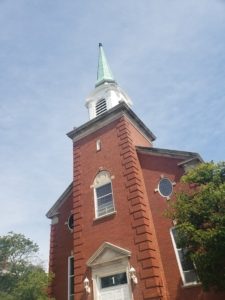Pulling on Threads – The Rest of the Story
 “Don’t fall! Don’t look down! Don’t fall! Don’t look down!” Those messages kept playing over and over in my head! Here I was, 20 feet up, clinging to a wooden ladder that wobbled and shuddered with every step I climbed. The pounding in my chest was part fear, part adrenaline, and part excitement. I was about to lay my eyes (and my hands) on THE bell…my great-great-grandfather’s bell…not quite Indiana Jones and the Holy Grail, but pretty damn cool!
“Don’t fall! Don’t look down! Don’t fall! Don’t look down!” Those messages kept playing over and over in my head! Here I was, 20 feet up, clinging to a wooden ladder that wobbled and shuddered with every step I climbed. The pounding in my chest was part fear, part adrenaline, and part excitement. I was about to lay my eyes (and my hands) on THE bell…my great-great-grandfather’s bell…not quite Indiana Jones and the Holy Grail, but pretty damn cool!
A couple of months ago, I told you the story of my search for the bell my great-great-grandfather procured in 1867 (Pulling on Threads). You know…the story involving five churches, two foundries, and two bells cast twenty years apart over 100 years ago? Well, here’s “the rest of the story!”
I could not let it go. There had to be more. There had to be proof that the Lansing, Illinois, bell was the original. I continued to pull on that thread.
Since the picture of the bell clearly showed it was Cast by A. Fulton. I began to research A. Fulton of Pittsburgh. Andrew Fulton. The foundry did indeed cast church bells in the 1860s. Andrew Fulton, Jr. joined his father in making bells. Junior grew up to be the mayor of Pittsburgh. Now, that is an interesting connection. The foundry went through several name changes as partners joined or left.
My Google searches were not turning up business records that may have been saved. However, the search did reveal that the American Bell Association was having its annual convention this year in…Pittsburgh. One of the educational tracks…Fulton Bells! I reached out to the general email address for the convention and asked if they could put me in touch with the person running the session.
I soon heard back, and they confirmed that Fulton did indeed go through many name changes during its years in business. Since no date was cast into the bell, verifying when it was cast was hard. He did mention the bell “was probably made no later than 1865.” Hmmm, curious. When I told him the story of the fire in 1945 (see Pulling on Threads), he was surprised the bell had survived such a fire. The fall from the steeple would be enough to crack the bell. If the fall didn’t crack it, the intense heat would undoubtedly melt it. Hmmm, curious. He asked if I knew the diameter of the bell. I did not. He explained the approximate weight of the bell can be calculated from the diameter.
I continued to pull on threads.
My research uncovered a book that references Fulton Bells. Large Bells of America: History of Church Bells, Fire Bells, School Bells, Dinner Bells and Their Foundries by Neil Goeppinger. Of course, I ordered a copy!
While I waited, somewhat impatiently, I might add, for the book to arrive. I emailed the First Church (PCA), formerly The First Reformed Church of Lansing. Perhaps they had information about the bell. That started a chain of emails with the church administrative assistant… well, two church administrative assistants both named Sheila. The Sheilas were gracious enough to send me copies of their church rolls from 1861, where some Ton ancestors appeared. They also put me in touch with a local historian who had written about the bell and climbed the belfry to see it.
The book arrived…finally. Of course, I first examined the index and turned to the pages about the Fulton Bells. I was excited to read that they did indeed cast some undated bells with the inscription “Cast by A. Fulton” on the bell. This was confirmation I was on the right track!
I wanted to reach out to the author, but the book had no contact information for him. Google was not much help either. Since the author was a former American Bell Association president, I reached out to my new friends at the Association. Could they put me in touch with Mr. Goeppinger?
Within a few days, I had a voicemail message from him!
I told him the story of the bell, its relationship with my great-great-grandfather, the confusion over the foundry, and the fire. “I’m surprised it survived. Most bells don’t.” He quickly dug through his records and found the information he had on Fulton. “The bell you have was probably cast in 1863 or before,” he said. I explained my GG Grandpa bought it in 1867 or 1868. He said it was possible, but I could tell he had doubts by the drawn-out way he said it. Hmmm, curious. I promised to be back in touch as I learn more.
I reached back out to the Sheilas. “Would it be possible for me to see the bell? Could I climb up in the tower and see it with my own eyes? I would love to measure it.” The response was quick…of course!
 A couple of weeks later, my wife Carmen and I arrived at the church! After introducing ourselves, we were introduced to Mark, the church’s Administrator. He led the way down the hall, through the sanctuary, up the stairs to the balcony, and up a second set of stairs to the control room. The room overlooked the sanctuary and was filled with miscellaneous electronic gear. On one wall was a black metal ladder leading up to a small square hole in the ceiling.
A couple of weeks later, my wife Carmen and I arrived at the church! After introducing ourselves, we were introduced to Mark, the church’s Administrator. He led the way down the hall, through the sanctuary, up the stairs to the balcony, and up a second set of stairs to the control room. The room overlooked the sanctuary and was filled with miscellaneous electronic gear. On one wall was a black metal ladder leading up to a small square hole in the ceiling.
I followed Mark up the ladder and into the attic of the church. We were in a room approximately 20 feet square. One side of the room was open to the attic itself where a long row of rafters formed the roof of the building. The room we were standing in was empty except for a rope that came down from the ceiling and disappeared into the floor. “That’s the rope we use to ring the bell,” Mark explained, “it hangs into the control room.” Doh! In my excitement to climb the ladder in the control room, I had not even noticed.
 On one side of the room was a tall wooden ladder. The rails were 2x4s, perhaps 25 feet in length. The rungs were 1x4s. As Mark climbed, he stated, “This is a one-person-at-a-time ladder. Wait until I get to the top, and be careful. It wobbles quite a bit.” Mark soon disappeared into a hole in the ceiling. As I began to climb, I realized Mark was right…it did wobble quite a bit, more like shake and shimmy. I was hoping it would hold my weight!
On one side of the room was a tall wooden ladder. The rails were 2x4s, perhaps 25 feet in length. The rungs were 1x4s. As Mark climbed, he stated, “This is a one-person-at-a-time ladder. Wait until I get to the top, and be careful. It wobbles quite a bit.” Mark soon disappeared into a hole in the ceiling. As I began to climb, I realized Mark was right…it did wobble quite a bit, more like shake and shimmy. I was hoping it would hold my weight!
“Don’t look down! Don’t fall!”
 Minutes later, I went through the hole in the ceiling and entered the belfry. Here was THE BELL! I was touching the bell my great-great-grandfather purchased with money he helped to raise. The bell he transported from Chicago by ox cart. The bell that called him and my great-great-grandmother to worship.
Minutes later, I went through the hole in the ceiling and entered the belfry. Here was THE BELL! I was touching the bell my great-great-grandfather purchased with money he helped to raise. The bell he transported from Chicago by ox cart. The bell that called him and my great-great-grandmother to worship.
Aside from the bell, there was barely room for Mark and me. I took several pictures, including one showing the bell was cast in Pittsburgh, not Troy, New York. Mark was kind enough to take a picture of me crouching beside the bell. Before I knew it, it was time to descend out of the belfry.
“Don’t look down! Don’t fall!”
I waited in the attic for Mark to descend the ladder and then descended the next ladder back to the control room. Sure enough, the rope was hanging from a hole in the ceiling, knotted in several places to enable the ringer to keep a solid grip. Carmen and Sheila stood in the sanctuary, looking up at us. Carmen asked if I had wrung the bell. I wasn’t sure it would be allowed, but Sheila encouraged Mark to let me pull on the rope. “Amazing,” I thought as I rang the bell my great-great-grandfather purchased with money he helped to raise! The bell he transported from Chicago by ox cart! The bell that called him and my great-great-grandmother to worship!
But was it?
A few days after our trip, I received an email from Mark. Later in the day of our visit, he talked with one of the church janitors, Dale, and told him the story of our visit. Dale said, no, that is not the original bell. The original bell was destroyed in the fire of 1945. In fact, he has the clapper from the original bell hanging in his garage.
POP! My bubble of euphoria just burst! I was devastated. But I told Mark it was still very cool to climb the bell tower, see the bell, and ring a 150-year-old bell! I asked him to pass my phone number along to Dale. I would love to talk to him about the bell.
A few days later, Dale called.
His grandfather was a member of the First Reformed Church of Lansing. He served as the chairman of the Building and Grounds Committee during the time of the fire. He was one of the first on the scene and watched his dear church become engulfed in flames and burn to the ground.
As the steeple burned, the bell slammed to the ground, making an incredible sound. The steeple toppled into the street.
A few days later, Dale’s grandfather was sifting through the rubble. The bell had broken into three pieces. He found the clapper bent, partially melted, and buried in ash. He took it home and hung it in his barn. When his grandfather passed away, his father and uncle were sorting through his belongings. His uncle told his father to take the clapper because he still attended the church. Later, Dale’s father gave him the clapper, and he hung it in his garage.
If his grandfather ever told him where the bell that hangs in the church today came from, he does not remember. Probably some other church in the area.

Photo: The Lansing Journal
So, there you have it…the rest of the story! It has been an interesting journey. I learned a lot about bells and their history, made some new friends, and uncovered a bit of history…just not the story I wanted to uncover!





Leave a Reply
Want to join the discussion?Feel free to contribute!